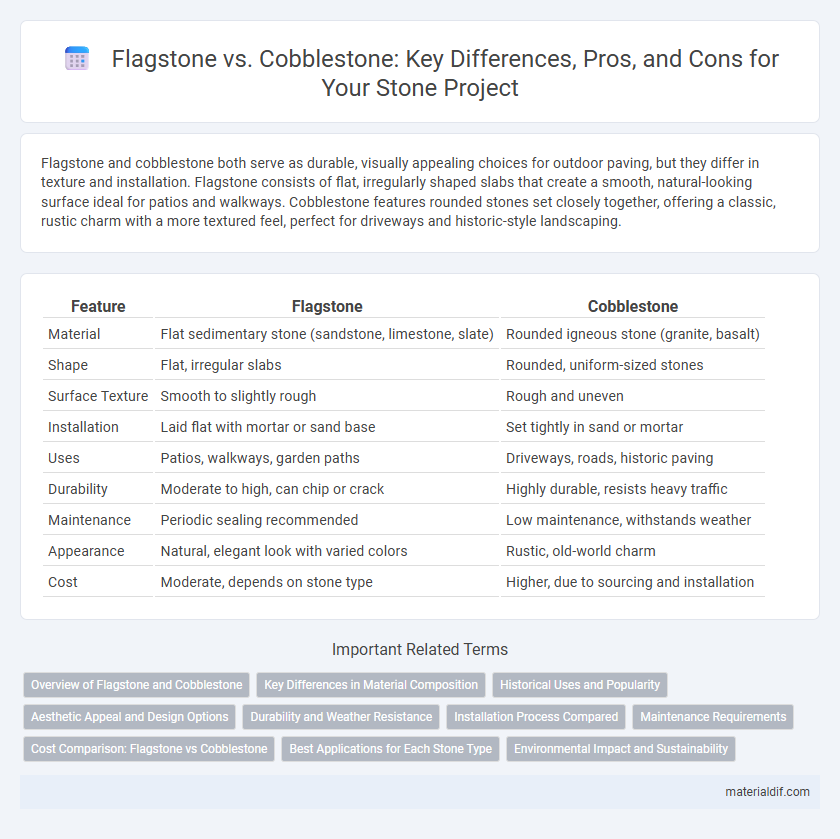Flagstone and cobblestone both serve as durable, visually appealing choices for outdoor paving, but they differ in texture and installation. Flagstone consists of flat, irregularly shaped slabs that create a smooth, natural-looking surface ideal for patios and walkways. Cobblestone features rounded stones set closely together, offering a classic, rustic charm with a more textured feel, perfect for driveways and historic-style landscaping.
Table of Comparison
| Feature | Flagstone | Cobblestone |
|---|---|---|
| Material | Flat sedimentary stone (sandstone, limestone, slate) | Rounded igneous stone (granite, basalt) |
| Shape | Flat, irregular slabs | Rounded, uniform-sized stones |
| Surface Texture | Smooth to slightly rough | Rough and uneven |
| Installation | Laid flat with mortar or sand base | Set tightly in sand or mortar |
| Uses | Patios, walkways, garden paths | Driveways, roads, historic paving |
| Durability | Moderate to high, can chip or crack | Highly durable, resists heavy traffic |
| Maintenance | Periodic sealing recommended | Low maintenance, withstands weather |
| Appearance | Natural, elegant look with varied colors | Rustic, old-world charm |
| Cost | Moderate, depends on stone type | Higher, due to sourcing and installation |
Overview of Flagstone and Cobblestone
Flagstone features flat, thin slabs of sedimentary rock commonly used for patios, walkways, and flooring due to its natural, irregular shapes and smooth surface. Cobblestone consists of small, rounded stones typically sourced from riverbeds, known for durability and a rustic, textured appearance ideal for streets and driveways. Both materials offer unique aesthetic and functional qualities, with flagstone emphasizing elegance and cobblestone providing robust, historical charm.
Key Differences in Material Composition
Flagstone typically consists of sedimentary rocks such as sandstone, limestone, or slate, known for their flat, broad surfaces ideal for paving. Cobblestone is made from naturally rounded igneous or metamorphic stones like granite or basalt, characterized by their durability and rounded shapes. The key difference lies in flagstone's layered structure allowing thin slabs, while cobblestone is composed of dense, individual stones suited for robust, textured pathways.
Historical Uses and Popularity
Flagstone has been widely used in historical architecture for centuries due to its flat, thin slabs ideal for paving walkways, patios, and flooring in ancient civilizations like the Romans and Native Americans. Cobblestone, composed of rounded stones naturally smoothed by rivers, was traditionally favored for roadways and streets in medieval Europe for its durability and ease of maintenance. The popularity of flagstone continues in modern landscaping for its aesthetic versatility, while cobblestone remains iconic in historic district restorations and classic urban designs.
Aesthetic Appeal and Design Options
Flagstone offers a natural, flat surface with irregular shapes and earthy colors, creating a rustic and organic aesthetic ideal for patios and walkways. Cobblestone features rounded, uniform stones that provide a classic, old-world charm and a visually textured surface, commonly used in driveways and pathways. Design options with flagstone emphasize versatility in patterns and colors, while cobblestone excels in durability and historical character.
Durability and Weather Resistance
Flagstone exhibits excellent durability with a dense, non-porous surface that resists cracking and erosion, making it ideal for high-traffic and outdoor areas. Cobblestone, composed of natural rounded stones, offers superior weather resistance due to its ability to withstand freeze-thaw cycles and heavy rainfall without significant wear. Both materials provide long-lasting performance, but flagstone's flatter surface ensures more stable footing under diverse weather conditions.
Installation Process Compared
Flagstone installation requires precise leveling and often a sand or mortar base to ensure stability and uniformity, making it ideal for patios and walkways with flat surfaces. Cobblestone installation is more labor-intensive, involving setting stones individually into a compacted base of gravel and sand, then filling joints with mortar or sand to accommodate the natural irregularities of the rounded stones. Both materials demand skilled craftsmanship, but cobblestone installation takes longer due to the complexity of fitting uneven stones securely.
Maintenance Requirements
Flagstone requires minimal maintenance due to its flat surface, making it easier to sweep and clean, while also being more resistant to cracking and shifting. Cobblestone demands more frequent upkeep because of its uneven surface, which can trap dirt and weeds between stones, necessitating regular weeding and joint refilling. Both materials benefit from periodic sealing to enhance durability and prevent staining, but flagstone typically offers lower long-term maintenance costs.
Cost Comparison: Flagstone vs Cobblestone
Flagstone typically costs between $5 and $15 per square foot, offering an affordable option for patios and walkways with natural, flat surfaces. Cobblestone, priced higher at $20 to $30 per square foot, involves more labor-intensive installation due to its irregular shapes and traditional set methods. Budget-conscious projects often favor flagstone for cost efficiency, while cobblestone is chosen for its historic charm despite the higher expense.
Best Applications for Each Stone Type
Flagstone is ideal for creating smooth, flat surfaces such as patios, walkways, and pool surrounds due to its thin, and easily cut slabs that provide a natural look and durable wear. Cobblestone is best suited for driveways and pathways requiring high durability and rustic charm, as its rounded edges and robust structure withstand heavy traffic and weathering effectively. Choosing between flagstone and cobblestone depends on the desired aesthetic and functional requirements of the outdoor space.
Environmental Impact and Sustainability
Flagstone and cobblestone differ significantly in environmental impact and sustainability, with flagstone often sourced from natural sedimentary rocks requiring less processing, thereby reducing carbon emissions. Cobblestone, typically made from granite or other igneous stones, demands intensive quarrying and higher energy consumption during extraction and shaping, leading to a larger carbon footprint. Sustainable landscaping prioritizes flagstone due to its durability, natural permeability for water runoff, and minimal ecological disruption during harvesting.
Flagstone vs Cobblestone Infographic

 materialdif.com
materialdif.com